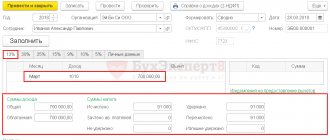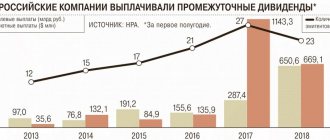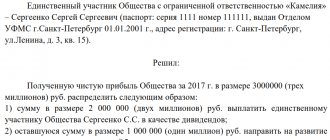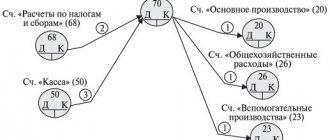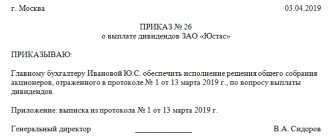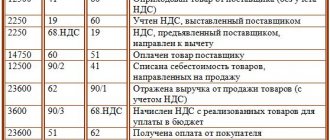Responsibility for non-payment of personal income tax
For violation of the procedure for calculating and paying personal income tax, liability is provided for both tax agents (employers) and for individuals themselves who independently received a profit. If personal income tax is not paid on time, a tax liability arises, which must be transferred to the budget. The overdue amount is subject to a penalty, which is a kind of reimbursement of the Treasury's costs for the fact that the taxpayer did not fulfill his obligations on time.
Failure to pay or not pay in full personal income tax, which arose due to an understatement of the tax base, may be punished in the form of a penalty. Collection in this case is possible in the amount of 20% of the debt amount or 40% if the taxpayer committed these actions intentionally. An understatement of the tax base is possible if the taxpayer indicates in the declaration those deductions that he is not entitled to apply.
Purchasing works and services from an individual
Another situation that may arise is the purchase of work or services (for example, rental of non-residential premises) by an organization from an individual. By virtue of Art. 226 of the Tax Code of the Russian Federation, in this case, the organization is obliged to withhold personal income tax from the amount of payments, pay it to the budget, and transfer the amount to the seller minus personal income tax at a rate of 13% (with the exception of income listed in Article 217 of the Tax Code of the Russian Federation).
In this case, the following transactions are made:
Dt 08 (10, 20, 26, 44) Kt 76 “F. AND ABOUT." (60) - a product (service) was purchased from an individual.
Dt 76 "F. AND ABOUT." (60) Kt 68 “Personal Income Tax” - personal income tax is accrued (withheld).
Dt 68 “Personal Income Tax” Kt 51 - Personal income tax is transferred to the budget.
Dt 76 "F. AND ABOUT." (60) Kt 51 - the amount for a product (service) is transferred to an individual minus personal income tax.
The main thing to remember is that personal income tax is taken from the income of a specific individual, and no matter what account is used when calculating it, it is necessary to conduct analytics on it for each individual from whose income personal income tax was withheld. It should also be remembered that tax-free income of an individual is established by law - all of them are listed in Art. 217 Tax Code of the Russian Federation.
Read more about non-taxable income in the article
“Income not subject to personal income tax (2018-2019)” .
Postings and accounts
After personal income tax is calculated, postings are made according to Kt account 68, if we are talking about withholding. For debit turnovers there is a different numbering:
- for payment of dividends to shareholders and founders - account 75;
- when withholding tax from wages – 70;
- if we are talking about material assistance - 73;
- for deductions from civil law income – 76;
- for short-term loans from individuals – 66;
- long-term loans – 67;
When transferring the total personal income tax to the budget - Dt 68 and credit turnover on the 51st account.
Payroll postings are typically made on the last day of the month. If we are talking about other income, then postings are made on the same day. This accounting manipulation is mandatory and is reflected in the relevant registers. Account identification numbers are also always used to make documentation and reporting clear.
The implementation of such operations is prescribed by law and is mandatory for various organizations and individual entrepreneurs paying income to individuals
It is important to consider that personal income tax can be withheld not only from the wages that employees receive, but also from other income received and payments made. For example, when purchasing a service or product from an individual
Also see “Reflecting the accrual and payment of dividends in accounting.”
Purchasing works and services from an individual
Another situation that may arise is the purchase of work or services (for example, rental of non-residential premises) by an organization from an individual. By virtue of Art. 226 of the Tax Code of the Russian Federation, in this case, the organization is obliged to withhold personal income tax from the amount of payments, pay it to the budget, and transfer the amount to the seller minus personal income tax at a rate of 13% (with the exception of income listed in Article 217 of the Tax Code of the Russian Federation).
In this case, the following transactions are made:
Dt 08 (10, 20, 26, 44) Kt 76 “F. AND ABOUT." (60) - a product (service) was purchased from an individual.
Dt 76 "F. AND ABOUT." (60) Kt 68 “Personal Income Tax” - personal income tax is accrued (withheld).
Dt 68 “Personal Income Tax” Kt 51 - Personal income tax is transferred to the budget.
Dt 76 "F. AND ABOUT." (60) Kt 51 - the amount for a product (service) is transferred to an individual minus personal income tax.
The main thing to remember is that personal income tax is taken from the income of a specific individual, and no matter what account is used when calculating it, it is necessary to conduct analytics on it for each individual from whose income personal income tax was withheld. It should also be remembered that tax-free income of an individual is established by law - all of them are listed in Art. 217 Tax Code of the Russian Federation.
Read more about non-taxable income in the article
“Income not subject to personal income tax (2018-2019)” .
Examples of personal income tax calculation
An example of calculating personal income tax from employee wages
Every working individual receives monthly income in the form of wages, however, an individual does not independently calculate and pay personal income tax from wages. This is due to the fact that the responsibility for calculating and paying personal income tax on wages falls on employers, who in this case act as tax agents. The employee receives a salary minus tax.
Having calculated the salary, the accountant determines the required amount of deductions for the employee, subtracts the deductions from the salary, and a tax rate of 13% is calculated from the resulting difference.
Toropov received a salary for January 2015 in the amount of 30,000 rubles. He has one child. Let's calculate the personal income tax that the employer must pay on Toropov's salary.
Since Toropov has one child, he is entitled to a standard tax deduction of 1,400 rubles.
Personal income tax = (30000 – 1400) *13% = 3718 rub.
Toropov’s salary in hand = 30,000 – 3,718 = 26,282 rubles.
Postings for accounting for personal income tax from salary:
- D44 K70 in the amount of 30,000 - Toropov’s salary accrual for January 2015 is reflected.
- D70 K68.NDFL in the amount of 3718 - personal income tax is withheld from accrued salaries.
- D70 K50 - in the amount of 26282 - wages were paid to Toropov.
- D68.NDFL K51 – the amount of tax is transferred to the budget.
Please note that to reflect the amount of personal income tax, account 68 is used, in which a separate sub-account is opened. The debit of account 68 reflects the transfer of tax, and the credit reflects its accrual for payment.
An example of calculating personal income tax on dividends:
If an individual has a share in the authorized (share) capital of an organization, then he has the right to receive income in the form of dividends. Dividends are calculated from the organization's net profit.
Personal income tax on dividends must be withheld by the organization paying them. That is, this organization acts as a tax agent. An individual must receive the dividend amount minus tax.
Since 2015, a rate of 13% has been applied to dividends (previously the rate was 9%).
Toropov received dividends in the amount of 30,000 rubles. Let's calculate personal income tax on dividends.
Personal income tax = 30000 *13% = 3900.
Dividends receivable = 30,000 – 3,900 = 26,100.
Postings for accounting for personal income tax on dividends:
- D84 K75 in the amount of 30,000 - dividends were accrued to Toropov for participation in the authorized capital of the company.
- D75 K68.NDFL in the amount of 3900 - the amount of tax on dividends was withheld.
- D75 K50 for 26100 – dividends were paid to Toropov in cash.
- D68.NDFL K51 for 3900 – the amount of tax is transferred to the budget.
An example of calculating personal income tax on a loan
Tax is imposed on income received in the form of interest from the transfer of funds on credit.
Toropov lent the organization a loan in the amount of 30,000 rubles. for a period of 6 months. The income received in the form of interest on this loan is 3,000 rubles. Let's calculate the tax on interest.
A 13% rate is also applicable for this type of income.
Personal income tax = 3000 * 13% = 390 rubles.
Postings for accounting for personal income tax on loan interest:
- D50 K66 for 30,000 - reflects the amount of credit money received from Toropov.
- D91/2 K66 for 390 - accrued interest on the loan is written off as other expenses.
- D66 K68.NDFL for 390 – tax is withheld from interest on the loan.
- D66 K50 for (30000+3000-390) – funds were returned to Toropov, taking into account accrued interest minus personal income tax.
- D68.NDFL K51 at 390 – the amount of tax to the budget is transferred.
Calculation of personal income tax on travel expenses
Travel expenses in terms of daily allowance and unconfirmed costs for renting residential premises, in accordance with clause 3 of Art. 217 of the Tax Code of the Russian Federation are standardized for personal income tax purposes. Daily allowances in excess of the norm and expenses for renting residential premises that are not documented are subject to personal income tax at a rate of 13%.
The norms for daily allowance are set within the following limits: for business trips in Russia - no more than 700 rubles. per day, for business trips abroad - no more than 2,500 rubles. in a day.
Read about similar restrictions introduced for daily allowances in 2017 regarding the calculation of insurance premiums in this article.
When an organization pays daily allowance to an employee by internal order above the established norm, the following entries are made:
Dt 71 "F. Acting employee" Kt 50 (51) - an advance was issued to the accountable person for travel expenses.
Dt 44 (20, 26) Kt 71 “F. Acting employee”—travel expenses are accrued.
Dt 70 "F. Acting employee" Kt 68 "Personal Income Tax" - personal income tax is charged on amounts for business trips that exceed the norm. The date of receipt of such income from 2021 is considered to be the last day of the month in which the corresponding advance report was approved (subclause 6, clause 1, article 223 of the Tax Code of the Russian Federation). Previously, it was taken into account on the date of approval of the advance report.
Personal income tax penalties in 2021
The calculation of penalties in 2021 is made in accordance with Article 75 of the Tax Code of the Russian Federation:
- If the delay is less than 30 days, then organizations are charged a penalty in the amount of 1/300 of the Central Bank refinancing rate currently in effect.
- If the delay is more than 30 days, then penalties are charged in the amount of 1/300 of the refinancing rate of the Central Bank of the Russian Federation for the first 30 days and in the amount of 1/150 of the refinancing rate of the Central Bank of the Russian Federation starting from the 31st day of delay.
The accrual of penalties, their payment and write-off occurs on the basis of the Tax Code of the Russian Federation, as well as PBU 10/99. The entire process of generating entries is possible in two versions, depending on the way the accounting or tax accounting requirements are interpreted. From the point of view of accounting standards, these penalties are considered as penalties, and they are written off in the same amount. As for tax accounting, penalties and fines differ both in characteristics and in the method of reflection. Penalties do not have any signs of a fine, since they do not have a fixed amount and are not taken into account when reducing the tax base. In this case, 91 and 99 accounts can be used, and the chosen method must be fixed in the company’s accounting policy.
Let's take a closer look at an example. delayed the payment of personal income tax for 10 days in the amount of 50,000 rubles. The company calculated the penalty and paid it along with the amount of the debt. The refinancing rate on the day of delay is 7.75%. Therefore, the amount of the penalty will be:
50,000 x (1/300 x 7.75) x 10 = 129.17 rubles
The company made the following accounting entries:
| Business transaction | D | TO |
| Personal income tax penalties accrued in the amount of 129.17 rubles | 99 | 68.4 |
| Personal income tax penalties in the amount of 129.17 rubles were paid from the current account | 68.4 | 51 |
Accrual of personal income tax on dividends paid
Dividends are the income of the founders. If the founder is an individual, then from January 1, 2015, his income is subject to personal income tax at a rate of 13% (before 2015, the rate was 9% - Article 224 of the Tax Code of the Russian Federation). Accounting for paid dividends for founders who are employees of the organization can be kept in both account 70 and account 75, but if the founder is not an employee of the organization, then only account 75 is used.
Dt 84 Kt 75 “F. Acting founder”—dividends accrued.
Dt 75 "F. Acting founder" Kt 68 "Personal income tax" - personal income tax is accrued (withheld) from dividends.
Dt 75 "F. Acting founder" Kt 51 - dividends were paid to the founder minus personal income tax.
Dt 68 “NDFL” Kt 51 - paid by personal income tax to the budget.
For the payment of personal income tax on dividends paid, look for the KBK in this article.
Personal income tax postings
All operations related to payroll calculation are reflected in accounting entries. When personal income tax is accrued or withheld from wages, the posting is reflected in a memorial order filled out for each reporting month. We will look into which subaccounts are used in operations related to the calculation and payment of tax in our article.
Main accounts for reflecting personal income tax
In principle, there are no difficulties with reflecting in accounting entries for the accrual, withholding and payment of personal income tax. Questions often arise with tax refunds.
The Tax Code has approved the rules for keeping records of tax transactions, which indicate that the tax agent is obliged to accrue, deduct and pay personal income tax from the taxpayer’s salary and reflect the transactions accordingly in accounting entries.
Income tax accounting is carried out in subaccount 68, if personal income tax is accrued, the posting is reflected on the loan. Corresponding accounts will be based on the accrual situation. Below we present frequently encountered situations that arise with the reflection of personal income tax in accounting.
Personal income tax postings for material benefits
Income associated with material benefits is the provision of a low-interest or zero-rate loan to an employee, where the lender is an enterprise. The amount of the difference between the percentages constitutes the tax base. The amount of the benefit depends on the interest rate provided by the organization that issued the loan and on the established interest rate of the Central Bank on the date of receipt of the loan.
The accrual and deduction of personal income tax transactions are reflected as follows:
| Debit | Credit | Operation |
| 73 | 51 | Transfer of borrowed funds to the employee’s bank account |
| 73 | 91 | calculated amount of interest on the loan (reflected for each reporting month) |
| 73 | 68 | Tax calculated on the amount of material benefit (for the reporting month) |
| 68 | 51 | Payment of tax to the State budget (for the reporting month) |
Personal income tax calculator
Personal income tax postings under an employment contract
Labor relations between an employer and an individual under a contract are the main type of income of the latter, where the enterprise acts as a tax agent. Payroll, as well as personal income tax accrual and withholding, is reflected in the memorial order as follows:
| Debit | Credit | Operation |
| 44 | 70 | Employee payroll |
| 70 | 68 | Tax is calculated on income from wages and other types of taxable income |
| 70 | 51 | Crediting salary to employee's bank account |
| 68 | 51 | Transfer of tax to the budget |
How to calculate personal income tax
Personal income tax postings for travel expenses
In accordance with the Tax Code, travel expenses are taxed only if the established daily expense limit is exceeded, which is 700 rubles within the territory of the Russian Federation, 2500 rubles abroad.
When paying an employee funds for a business trip above the established daily allowance (by order of the manager), the income received is subject to personal income tax at a rate of 13%.
The accrual of travel allowances and personal income tax deductions will be reflected in the memorial order as follows:
| Debit | Credit | Operation |
| 71 | 50 (51) | An advance was issued to the employee for future expenses |
| 44 (20, 26) | 71 | Travel allowance amount accrued |
| 70 | 68 | Income tax is calculated on the difference between the established daily rate and the amount given to the employee |
| 68 | 51 | Tax transferred to the State budget |
Fine for non-payment of personal income tax
Personal income tax postings for dividends
Reflection of accounting entries for the payment of dividends and the accrual of personal income tax entries will depend on whether the founder is an employee of this organization or not. In the case when the founder works at this enterprise, account 70 will be used, if he is not an employee of the company - account 75.
| Debit | Credit | Operation |
| 84 | 70 (75) | Amount of dividends accrued |
| 70 (75) | 68 | Personal income tax accrued |
| 70 (75) | 51 | The amount of dividends paid minus the withheld personal income tax |
| 68 | 51 | Tax transferred to the budget |
It is important to take into account that personal income tax is calculated for each employee separately, using the corresponding corresponding accounts. When compiling a memorial order, the entries for each account are summarized into a total amount
How to calculate personal income tax under an employment contract (formula)
The main type of income for which an organization becomes a tax agent for personal income tax is accruals under an employment contract.
As a rule, such payments are: wages, bonuses of various types, allowances, compensation in excess of the norm related to the employment contract.
From all these payments, minus the deductions provided (Articles 218, 219, 220 of the Tax Code of the Russian Federation), tax is withheld: monthly in the amount of 13% for residents and 30% for non-residents, except for those listed in Art. 227.1 Tax Code of the Russian Federation.
The formula for calculating personal income tax is as follows:
Personal income tax = (Dex - Deductible) × St,
- Personal income tax - the amount of tax to be withheld;
- Doh - the amount of employee income for the month, including bonuses, allowances, etc.;
- Deduction - the amount of deductions (children's, property, social) provided at the request of the employee;
- St - tax rate (13% for residents, 30% for non-residents).
Postings are made:
- Dt 44 (20, 26) Kt 70 “F.I.O. employee" - wages accrued;
- Dt 70 “F.I.O. employee" Kt 68 "Personal Income Tax" - personal income tax is accrued (withheld);
- Dt 70 “F.I.O. employee" Kt 51 (50) - wages issued;
The procedure for calculating personal income tax on material benefits (example)
When receiving a low-interest or interest-free loan from an organization (so-called financial assistance), the employee receives a material benefit in terms of saving on interest. It matters in what currency the loan agreement is drawn up.
If it is issued in rubles, then the threshold rate is 2/3 of the current refinancing rate established by the Central Bank of the Russian Federation on the date of receipt of income (clause 2 of Article 212 of the Tax Code of the Russian Federation).
NOTE! From 2021, the refinancing rate is equal to the key rate (directive of the Central Bank of the Russian Federation dated December 11, 2015 No. 3894-U) and is:
- from 01/01/2016 - 11% (information from the Bank of Russia dated 07/31/2015);
- from 06/14/2016 - 10.5% (information from the Bank of Russia dated 06/10/2016);
- from September 19, 2016 - 10% (information from the Bank of Russia dated September 16, 2016);
- from March 27, 2017 - 9.75% (information from the Bank of Russia dated March 24, 2017);
- from 05/02/2017 - 9.25% (information from the Bank of Russia dated 04/28/2017);
- from 06/19/2017 —– 9% (information from the Bank of Russia dated 06/16/2017).
If the loan is issued in foreign currency, then the established threshold value is 9% per annum (clause 2 of Article 212 of the Tax Code of the Russian Federation).
Moreover, in case of exceeding the threshold values, personal income tax is withheld at 35%.
It is better to consider the postings for calculating personal income tax using a specific example.
The organization issued a loan to employee Ivanov I.I. (resident of the Russian Federation) for a period of 1 year in rubles at a rate of 3% per annum with interest paid at the end of the loan term. Loan size - 500,000 rubles.
Dt 73 “Ivanov I. I.” Kt 50 - 500,000 rub. — the loan amount was issued to Ivanov on December 31, 2016.
Income from the amount of the benefit from 2021, regardless of the date of payment of interest, is determined monthly on the last day of the month. Let's calculate the amount of interest on the loan for January 2021. There was no partial repayment of the loan in January.
500,000 × 0.03 ×31/365 = 1,273.97 rubles.
Dt 73 “Ivanov I. I.” Kt 91 - RUB 1,273.97. — interest accrued for using the loan for January 2021.
We will calculate personal income tax on the amount of material benefit.
2/3 × 10% = 6.67% - threshold, taking into account the current refinancing rate.
6.67 – 3 = 3.67% - interest on material benefits.
500,000 × 0.0367 × 31/365 = 1,558.49 rubles. - material benefit for January 2021. Let's calculate personal income tax (35%) from it: 1,833.74 × 0.35 = 545 rubles.
If Ivanov were a non-resident of the Russian Federation, then the tax would be withheld at a rate of 30% (clause 3 of Article 224 of the Tax Code of the Russian Federation).
Dt 70 (73) “Ivanov I. I.” Kt 68 “NDFL” - 545 rubles. — Personal income tax on material benefits for January 2021 is withheld from the employee’s salary (or other income).
Dt 68 “NDFL” Kt 51 - 545 rubles. — Personal income tax from savings on interest for January 2021 is transferred to the budget.
Calculation of personal income tax on travel expenses
Travel expenses in terms of daily allowance and unconfirmed costs for renting residential premises, in accordance with clause 3 of Art. 217 of the Tax Code of the Russian Federation are standardized for personal income tax purposes. Daily allowances in excess of the norm and expenses for renting residential premises that are not documented are subject to personal income tax at a rate of 13%.
The norms for daily allowance are set within the following limits: for business trips in Russia - no more than 700 rubles. per day, for business trips abroad - no more than 2,500 rubles. in a day.
Read about similar restrictions introduced for daily allowances in 2017 regarding the calculation of insurance premiums in this article.
When an organization pays daily allowance to an employee by internal order above the established norm, the following entries are made:
Dt 71 "F. Acting employee" Kt 50 (51) - an advance was issued to the accountable person for travel expenses.
Dt 44 (20, 26) Kt 71 “F. Acting employee”—travel expenses are accrued.
Dt 70 "F. Acting employee" Kt 68 "Personal Income Tax" - personal income tax is charged on amounts for business trips that exceed the norm. The date of receipt of such income from 2021 is considered to be the last day of the month in which the corresponding advance report was approved (subclause 6, clause 1, article 223 of the Tax Code of the Russian Federation). Previously, it was taken into account on the date of approval of the advance report.
Paying taxes - how to reflect them in accounting entries
In such a situation, the organization itself must determine on which accounting accounts the personal income tax amounts will be taken into account, and consolidate the chosen procedure in the accounting policy order. In accounting, operations related to personal income tax calculations are carried out in accordance with the Instructions for the application of the Chart of Accounts for accounting of financial and economic activities of organizations, approved by Order of the Ministry of Finance of Russia on October 31, 2000 No. 94n “On approval of the Chart of Accounts for accounting of financial and economic activities of organizations and Instructions on its application" (hereinafter referred to as the Chart of Accounts). To summarize information about settlements with budgets for taxes and fees paid by an organization, account 68 “Calculations for taxes and fees” is intended.
Insurance LawPermalink
Personal income tax for individual entrepreneurs in the general mode: how to calculate and pay personal income tax
The tax office may ask for an explanation if it audits you. Then you will explain yourself. In your case, it was not a mistake, but an advance for the order, which was later cancelled. If there are questions, do you have documentary evidence of the operations? When the advance was transferred to you, the client probably wrote on the payment slip: payment for such and such services under such and such an agreement. When you returned the money to him, you had to indicate something like: return of the advance payment under such and such an agreement. This is all reflected in KUDIR as well. This is just an example. There are payments, there is a bank statement - you can explain. If everything is properly formalized, then they won’t ask about it.
The tax office sees what you wrote in the declaration and it transmits the income figure from the declaration to the Pension Fund. She can see something else, the same statement, only during verification, when she requests documents from you and, if necessary, from the bank. In addition, since 2017, contributions are transferred under the administration of the tax office, so now you will only have to deal with it.
Postings for withholding and transferring personal income tax
Transactions with personal income tax in modern accounting and tax accounting are carried out without fail when paying income to individuals. Let us consider in more detail what transactions are generated when accruing, withholding and transferring personal income tax.
We correctly reflect personal income tax withholding from wages
The main task of an accountant in the accounting department of an enterprise is the correct calculation of earned income, vacation pay, sick leave, night pay, compensation payments, various allowances, financial assistance and the accurate withholding of tax from this income. Regulatory acts provide that taxable total income includes dividends, winnings, prizes, gifts, compensation for travel expenses exceeding the daily expense limit established by the state.
Personal income tax is calculated within the framework of clause 3 of Art. 225 of the Tax Code of the Russian Federation, which defines all types of charges subject to taxation. Tax rates are clarified in the Tax Code, Art. 224.
The calculation is made using a standard formula, where the total tax is multiplied by the tax base by the tax rate:
Personal income tax = (salary - SV) * tax rate
where ZP is the amount of income received, rub.; SV - standard deductions, rub.
For example, in October 2021, salesman Anisimov worked for a whole month and his income amounted to 35,000 rubles. At the same time, he has the right to a standard benefit (deduction) for a five-year-old son in the amount of 1,400 rubles. based on the submitted application and a copy of the child’s birth certificate.
An enterprise, in the role of a tax agent, calculates the amount of tax and, no later than the day following the day of payment of income, transfers it to the budget. The tax calculation will be as follows:
Tax amount = (35,000 - 1,400) * 0.13 = 4,368 rubles.
The business journal will contain the main entries:
| № | Dt | CT | Amount, rub. | Primary document | |
| 1 | Accrued for October to Anisimov | 44 | 70 | 35 000 | Payroll or payslip |
| 2 | Personal income tax withheld | 70 | 68 | 4 368 | Payroll or payslip |
We prepare transactions for the transfer of personal income tax
Nowadays, the state clearly sets deadlines and methods for introducing accrued amounts into the budget. It is mandatory to transfer the entire amount of accrued tax to the budget settlement account on the day of payment of wages or no later than the next day after the payment of wages or other income to an individual. The wiring looks like this:
- Dt 68 Kt 51. The documentary basis is the payment order and bank statements.
- Dt 68 Kt 50. Cash order, cash book, bank receipt.
In this case, the tax payment process can be combined. The transfer is made in non-cash form from a current account, or in some situations, money can be deposited into a budget account in cash through the bank's cash desk.
Sample tax payment order:
In 2021, a new form of personal income tax report 6 was introduced, which provides a summary of data on a legal entity. The company reports on this form in terms of the total amount of money paid to employees, the total tax deduction, the rate and personal income tax paid from the income of the company's employees.
How to calculate personal income tax under an employment contract (formula)
The main type of income for which an organization becomes a tax agent for personal income tax is accruals under an employment contract.
As a rule, such payments are: wages, bonuses of various types, allowances, compensation in excess of the norm related to the employment contract.
From all these payments, minus the deductions provided (Articles 218, 219, 220 of the Tax Code of the Russian Federation), tax is withheld: monthly in the amount of 13% for residents and 30% for non-residents, except for those listed in Art. 227.1 Tax Code of the Russian Federation.
The formula for calculating personal income tax is as follows:
Personal income tax = (Dex - Deductible) × St,
- Personal income tax - the amount of tax to be withheld;
- Doh - the amount of employee income for the month, including bonuses, allowances, etc.;
- Deduction - the amount of deductions (children's, property, social) provided at the request of the employee;
- St - tax rate (13% for residents, 30% for non-residents).
Postings are made:
- Dt 44 (20, 26) Kt 70 “F.I.O. employee" - wages accrued;
- Dt 70 “F.I.O. employee" Kt 68 "Personal Income Tax" - personal income tax is accrued (withheld);
- Dt 70 “F.I.O. employee" Kt 51 (50) - wages issued;
Calculation and payment of fixed insurance premiums for individual entrepreneurs in 1C: Enterprise Accounting 8
If you generate payment orders in the program and then upload them to the client bank or send them to the bank directly from the program, you can click on the “Pay from a bank account” button. Payment orders will be created to write off the specified amounts (but these payment orders do not yet generate transactions). If you generate all payments in the client bank, and then load them into the program, then there is no need to press this button. We simply indicate the required amounts in the payments, send and load the statement into the program. The very fact of transferring the amounts of insurance premiums from the account in the program is reflected in the document “Write-off from the current account.” In the case of paying a fixed part to the Pension Fund of the Russian Federation, the type of operation must be selected in the document: “Payment of tax”, the tax - “Fixed contributions to the Pension Fund of the Russian Federation”, the type of obligation - “Contributions, constant part”. In this case, the correct accounting account will be entered automatically.
So, an individual entrepreneur must pay insurance premiums in a fixed amount before December 31 of the current year. This can be done at different frequencies: quarterly, half-yearly, one amount at the end of the year, etc. In 1C: Accounting 8, an insurance premium payment assistant has been implemented, which will tell you the required payment amounts for a given period. This assistant is located on the “Operations” tab.
Personal income tax withheld from wages - posting
- tax deduction;
- resident or non-resident status.
- their income is subject to a personal income tax rate of 13%;
- belong to the category of disabled people (disabled people), Chernobyl survivors, veterans, relatives of disabled people and veterans, parents with children under 18 years of age and others;
- their income, cumulatively since the beginning of the year, does not exceed 280,000 rubles.
For residents, the personal income tax rate is 13%, and for non-residents - 30%. A non-resident who resides in the country for more than 183 days becomes a resident.
Important
A tax deduction is an amount by which the taxable amount or tax base can be reduced. There are many types of tax deductions; let's look at the standard type of tax deduction as an example.
We prepare transactions for the transfer of personal income tax
Nowadays, the state clearly sets deadlines and methods for introducing accrued amounts into the budget. It is mandatory to transfer the entire amount of accrued tax to the budget settlement account on the day of payment of wages or no later than the next day after the payment of wages or other income to an individual. The wiring looks like this:
- Dt 68 Kt 51. The documentary basis is the payment order and bank statements.
- Dt 68 Kt 50. Cash order, cash book, bank receipt.
In this case, the tax payment process can be combined. The transfer is made in non-cash form from a current account, or in some situations, money can be deposited into a budget account in cash through the bank's cash desk.
Sample tax payment order:
In 2021, a new form of personal income tax report 6 was introduced, which provides a summary of data on a legal entity. The company reports on this form in terms of the total amount of money paid to employees, the total tax deduction, the rate and personal income tax paid from the income of the company's employees.
To record calculations for personal income tax, account 68 “Calculations for taxes and fees” is used. This is a complex account that has a number of sub-accounts. To account for personal income tax, a “NDFL” subaccount is opened in accounting account 68.
Credit 68 of the account reflects the accrual of tax for payment to the budget, and the debit indicates its payment.
Depending on the type of income received by the employee, credit 68 of account corresponds with the debit of the corresponding accounts for accounting for settlements with personnel.
Calculation of personal income tax from wages:
Petrov received a salary for November of 20,000. The employee has two children, and his salary since the beginning of the year has not exceeded 280,000.
A 13% rate applies to wages. For each child, Petrov is entitled to a standard deduction in the amount of 1400. Read about tax deductions and rates here.
Tax = (20000 – 1400 – 1400) * 13% / 100% = 2236
Postings for accounting for personal income tax from salary:
D44 K70 – wages accrued for November (20000)
D70 K68.NDFL – personal income tax withheld from wages (2236)
D70 K50 – wages paid (20000 – 2236 = 17764)
D68.NDFL K51 – personal income tax transferred to the budget (2236)
Calculation of personal income tax on dividends:
The founder Petrov received income in the form of dividends in the amount of 30,000.
Dividend income is taxed at a rate of 9%, no deductions are applied to this rate.
Tax = 30000 * 9% / 100% = 2700.
Postings for accounting for personal income tax on dividends:
D84 K75 – dividends accrued (30,000)
D75 K68.NDFL – dividend tax withheld (2700)
D75 K50 – dividends paid (27300)
D68.NDFL K51 – NDFL transferred to the budget (2700)
Accrual of personal income tax on dividends paid
Dividends are the income of the founders. If the founder is an individual, then from January 1, 2015, his income is subject to personal income tax at a rate of 13% (before 2015, the rate was 9% - Article 224 of the Tax Code of the Russian Federation). Accounting for paid dividends for founders who are employees of the organization can be kept in both account 70 and account 75, but if the founder is not an employee of the organization, then only account 75 is used.
Dt 84 Kt 75 “F. Acting founder”—dividends accrued.
Dt 75 "F. Acting founder" Kt 68 "Personal income tax" - personal income tax is accrued (withheld) from dividends.
Dt 75 "F. Acting founder" Kt 51 - dividends were paid to the founder minus personal income tax.
Dt 68 “NDFL” Kt 51 - paid by personal income tax to the budget.
For the payment of personal income tax on dividends paid, look for the KBK in this article.
